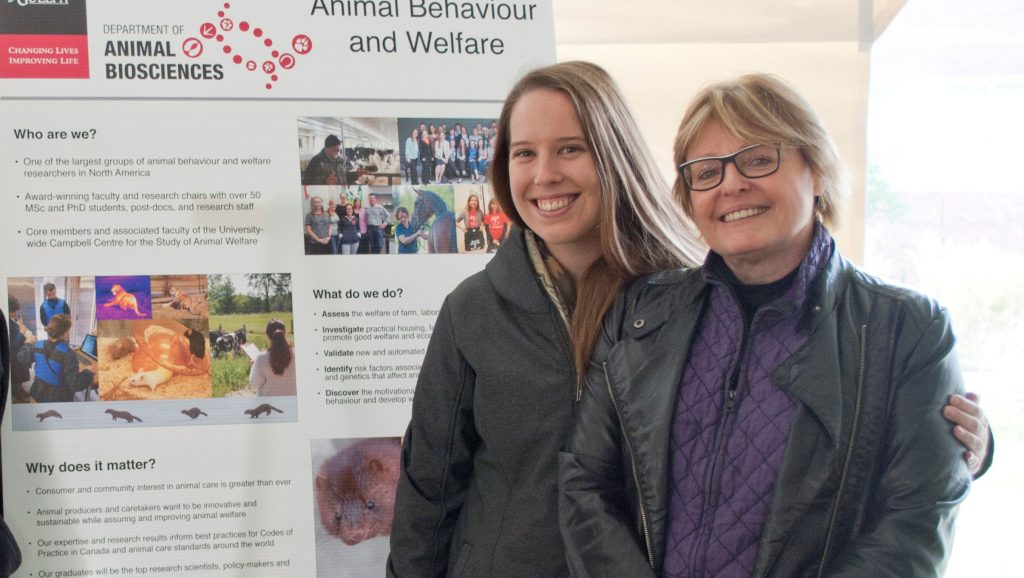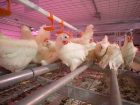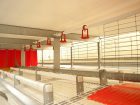
Nesting in enriched cages
By Treena Hein
Features Equipment Layers Poultry Equipment Production Alternative poultry housing Animal Housing Animal Welfare annex Canada Egg production Livestock Production Livestock Research Phasing Out Conventional Poultry Production Poultry Research Production Research Specialty ResearchWhile multiple studies have uncovered some of what affects nesting and pre-nesting behaviour, much remains to be learned.
 Michelle Hunniford (left), pictured with University of Guelph colleague Tina Widowski, has studied nesting behaviour in enriched housing for years.
Michelle Hunniford (left), pictured with University of Guelph colleague Tina Widowski, has studied nesting behaviour in enriched housing for years. Nesting behaviour in laying hens is complex, and according to poultry scientists such as Dr. Michelle Hunniford of the department of animal biosciences at the University of Guelph in Ontario, there’s a lot left to discover.
Hunniford has been studying nesting behaviour in enriched colony housing for many years and has found that hens’ nesting preferences are affected by many factors. At this point, it is unclear what percentage of farmers will switch to enriched cages, aviary or free-run production, but under the updated layer code of practice, all hens must be provided with nests and other furnishings intended to promote animal welfare.
Hunniford says it is important to understand the process hens go through in choosing a spot to lay and how they get themselves comfortable in preparation for laying is important. If hens are able to find a nest site that they like, they will show settled nesting behaviour, which she says means they are not very aggressive and are able to sit at the nest site, undisturbed by other hens. Sometimes, hens may choose a place to lay their eggs that’s outside of the designated nest area. According to Hunniford, this may mean that there isn’t enough nest space, or that the nest doesn’t appeal to those hens.
Hunniford believes more data on settling behaviour and choice of egg laying location should drive the design of enriched cages going forward, where design includes cage size to number of bird ratios, nest size, floor and nest space allowances, curtain characteristics and other aspects.
At this point in her research, she has found that some hens prefer different laying conditions over others. Strain and lighting can also affect nesting behaviour, and nest size alone may affect its attractiveness to hens. Hunniford adds that “it’s not a simple case of how much nest space is provided per bird, but how the hen perceives space in a nest, and that perception is influenced by many factors, including how many hens are motivated to nest at a particular time.”
Since not all hens necessarily prefer the same characteristics in a nest or its surroundings, Hunniford thinks there are some potential benefits from a bird welfare perspective to providing hens in enriched cage housing with more than one nest. She says hens that have satisfactory nest resources would spend less energy searching and competing for nests.
What’s more, speaking from a production and economic perspective, having more than one nest area in each cage would spread out the eggs laid in any one area. It would also lessen the possibility of shell damage.
Curtained nests
The research on the benefits of providing a nest with curtains is clear, and curtains are mandated for nests in all housing systems in the layer code of practice. There must be adequate space in curtained nests, however, as Hunniford’s research has shown that when there isn’t enough, hens may choose to lay on the floor in the scratch area. “More research also needs to be done on the design of nest curtains,” she notes. “Currently, the colour and design are arbitrary and determined by the housing manufacturer. For example, Farmer Automatic uses red curtains, Salmet uses yellow, and so on.” In addition, Hunniford notes that while giving hens the ability to enter and exit the nest from several directions through the curtains is an important factor for encouraging nest use, some hens will even seek out the most enclosed spaces within the nest. This is because they are quietest and provide the best chance of laying without being disturbed by other hens.
Hunniford is currently publishing data on how hens respond to either having only enclosed nests or only open nests with two different types of plastic nest surfaces: mesh and smooth. “To summarize the main results, hens preferred different surfaces depending on whether they were enclosed or not,” she explains. “Furthermore, hens would change their preference for a particular surface if the enclosure changed, moving from open to enclosed nests, showing that enclosure is a more important characteristic than surface.” Mesh mats are a more typical nest surface in Canada’s existing enriched cage housing systems, while smooth mats and other types of plastic surfaces have been traditionally used in the scratch area.
As to how the design of the enriched cage scratch area affects nesting behaviour, this comes down to the wire partition that is sometimes placed in the middle. “A bisecting partition keeps the area cleaner, and if there is no partition, a dirty scratch area may lead to poor feather quality of the hens,” Hunniford notes. “However, the partition can be perceived by some hens as another nest.” In furnished cage systems, the consequences of hens laying eggs outside of the nest are critical from both an economic and welfare perspective: floor laying may lead to broken eggs, egg eating and potentially cloacal cannibalism. In enriched cages, encouraging nest use is often associated with preventing eggs from becoming soiled or cracked and not with improving welfare. Hunniford says that mislaid eggs are not inherently a welfare issue, but may indicate that hens are identifying other areas of the cage as having the features of a nest, or that hens are being influenced by some design issue in the nest itself.
Pullet rearing and nesting
In Hunniford’s view, the effect of the pullet rearing environment on egg-laying preferences of hens should also be further investigated. She’s found that aviary-reared pullets adapted quicker to enriched cages than standard cage-reared pullets, showing more settled pre-laying activity such as less searching for a nest and fewer entries into the nest during the first weeks of lay.
“Other studies have shown that cognitive development and spatial awareness are positively affected by more complex rearing environments,” she says. “This may be the reason why hens from an aviary used the nest less – they perceived the furnished cages differently than hens reared in conventional pullet cages.” In agreement with the code, she believes matching the pullet-rearing environment to the adult environment is important, and that from the research results of Teresa Casey-Trott, there are bone health benefits when pullets are reared hens in an aviary regardless of the type of housing they will have as adult hens.
Future directions
Hunniford notes that there is still research to be done before the next update of the layer Code. “In terms of nesting, we don’t know what colour nest curtains hens prefer or what specifics of curtain design, for example longer or shorter, many small curtains or a few larger curtains,” she notes. “More research should also be done on the strength of hen preference for different characteristics like nest size, degree of enclosure within a nest, corners and more.”
Hunniford says there is still a prevailing assumption in housing design that one type of nest will suit all hens, but her research and that of others has shown that this is not the case. “I would anticipate that future Codes will require that more than one type of nest be provided in all housing systems,” she says. “To this end, further research should examine why some hens seem to prefer the crowded curtained nest area to lay their eggs, and others prefer the less-crowded open scratch area.”
Print this page


